By: Eric Zlokovitz (filling in for Keith Lockwood)
I just wanted to start off this week's fishing report with a "disclaimer" to advise you that I am filling in as a temporary fishing report writer while Keith is pursuing yellowfin tuna, marlin, and other great gamefish in Hawaii. Here is Keith with a huge yellowfin tuna from Hawaii. Back in the 1950's and 60's these big yellowfins were known as "Allison" tuna.
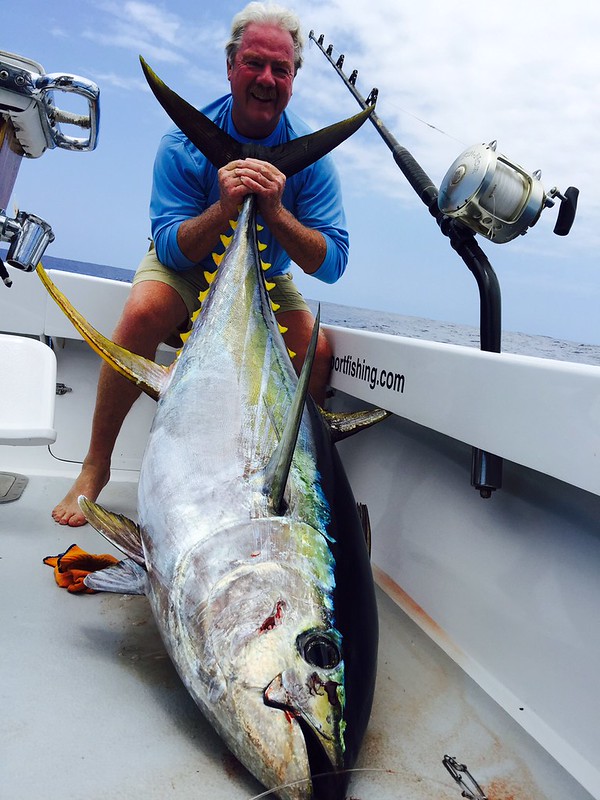
Photo courtesy of Keith Lockwood
I've been managing Maryland's Artificial Reef Program (MARI) for the last 6 years and I'm now taking on a new role as Recreational Fishing and Public Access Outreach Coordinator. As part of my role, I'll be informing you of the latest Maryland fishing news. One of the more interesting reports of the week was a leaping sturgeon sighting in the Nanticoke River, which is being further investigated.
We continue to receive a stream of reports from the bay and inland waters on the summer fishing scene. Many reports are sent to us directly from anglers via the Maryland Fishing Facebook Page, email, and Angler's Log. Striped bass fishing in the upper bay continues to be very good at most traditional locations from Swan Point south to Love Point, and the Bay Bridge. The red or white surge tube (hose) continues to be a hot trolling lure above the bridge, when fished behind weights ranging from 10-20 ounces, in 30-40 feet of water. Chumming with menhaden (also known as "Alewive") is also effective. Live-lining with spot is effective but small bait sized spot are scarce in the upper Bay with mainly the larger size available. Small bluefish are showing up in the upper Bay. They are generally smaller "snapper" size and tend to show up in chum slicks feeding on tidbits of menhaden. They should be starting to mix in with breaking rock on the surface. Bridge fishing for stripers has remained good using jigs such as Bass Assassins, BKD's, Z-Mans on 3/8-1/2 oz heads. Reports are coming from the Eastern and the Western sides, including the rockpiles. Some reports indicate the incoming tide is best, but generally, moving water is better than slack tide. Bottom fishing for spot and croaker is slow, but fishing for channel catfish is very good in portions of the upper Bay from the Susquehanna Flats to the Bridge. Catfishing improves with increased freshwater input from the Susquehanna River.
Once again, there is plenty of late summer white perch action in the upper bay region. I've received reports from the lower Severn River, ranging from Round Bay downstream to the Naval Academy. Most enjoy casting with ultra-light tackle along shoreline structure with small spinners such as the "super rooster tail" clothespin spinner, beetle spins, and the traditional inline spinners (Mepps, Rooster Tails, etc). Bait such as grass shrimp, crab, or bloodworm on a bottom rig, is effective and fun for kids. Additional baits such as shrimp, small minnows and peeler crab also work well. When bottom fishing hooks ranging from #2 - #6 are effective. In shallow water and under docks a single small hook with a tiny spilt shot and live grass shrimp is deadly on white perch and also catches a few small rockfish.
In the middle bay region striped bass fishing remains very good in most areas with the area from the Choptank River north getting the most attention. A white shad rig fished behind a planer worked well at Tolleys for Ben McCauley, who contacted us via Facebook. Striped bass are still holding around the mouth of Eastern Bay, the Hill, Gum Thickets and Hackett's. Many private boats and charter boats are chumming or live-lining spot in this area. Many of the striped bass caught in the general area are nice fish, often 25" or better. More bait continues to move into the area and breaking striped bass are being found in Eastern Bay by light tackle and fly rod anglers. Striped bass are also being found suspended along steep channel edges in Eastern Bay. The bluefish are generally found further south in the main Bay.
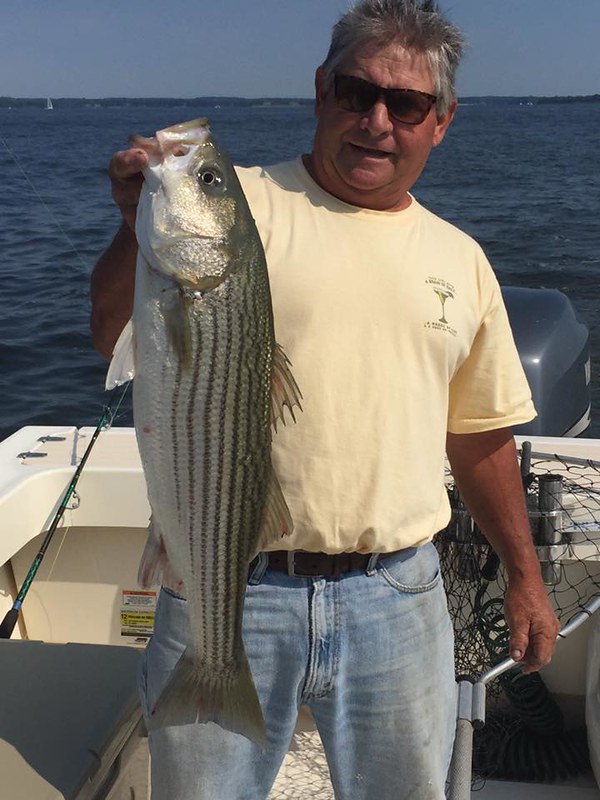
Photo courtesy of Ben McCauley
Last week's report indicated that spot were becoming more available at the "Sands" which is south of Black Walnut Point. This week I received a report that spot fishing had picked up in the Dolly's Lump area, just south of the Bay Bridge on the western shore. However, it remains difficult to catch the smaller "bait size" spot. As usual, small pieces of bloodworms or fishbites on #4 or #6 hooks and a simple "top-bottom" rig is the best way to catch spot. Fishing for croaker remains slow in the mid-Bay with most of the action occurring at dusk or during night hours. We'll see if the bottom fishing picks up in traditional bottom fishing areas in the lower Choptank, such as Cook Point.
In the lower Bay, I received my first confirmed report of spanish mackerel. The fishing is not fast but a few mackerel are being picked south of the Target Ship and towards the channel edges. Initial reports indicate that trolling # 1/2 and 1 Drones seems to be working better than Clark spoons. Hopefully, mackerel numbers will increase if weather remains dry and salinity increases. Here is a confirmed Spanish mackerel and nice bluefish sent in by Richard Wheeler.
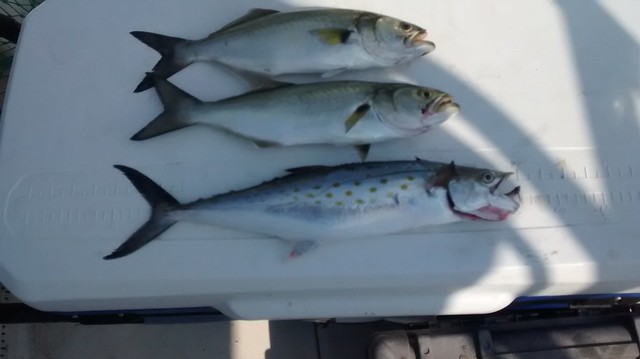
Photo courtesy of Richard Wheeler
Lower bay region fishing in general has revolved mostly around bluefish, and bottom fishing for croakers and spot. Striped bass fishing in the lower Bay south of the Choptank remains slow. Trolling with red surgical hoses (surge tubes) or spoons for bluefish is effective but they tend to be running on the small side. The trolling lures should be fished behind planers and inline weights. Weakfish, red drum, and rockfish, have been scarce.
Freshwater fishing remains in a summer pattern which means fish are still gravitating towards deeper water and shade conditions. Fish will be active in the early morning hours and late in the day. Trout, bass and panfish will be available in lakes and streams. Remember to focus on the dawn/dusk periods if you are interested in topwater action. Here is a nice underwater trout release shot taken by Kirk Bollinger from the Gunpowder River, right in Baltimore's backyard.
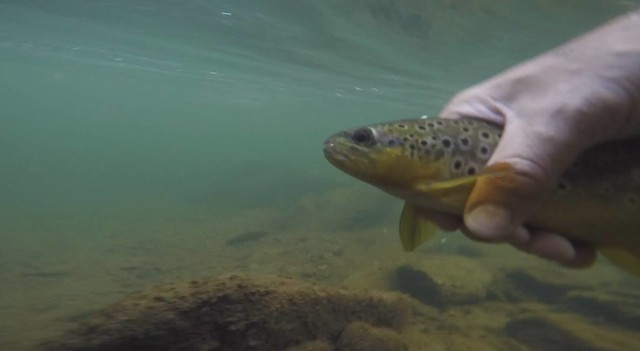
Photo courtesy of Kirk Bollinger
Alan Klotz, Western Region I Manager, Inland Fisheries Division, sent in a report for Garrett and Allegany Counties. He noted that August is still a good time to take the kids fishing (before school starts) for some good panfish action in our public lakes in Western Maryland. Alan fished Broadford Lake in Garrett County recently and had great action on bluegills and black crappies using mealworms fished under small bobbers near shaded shorelines and brush-piles. Deep Creek Lake is still producing a variety of panfish and sportfish – just drift fishing pieces of nightcrawlers on the edges of aquatic vegetation can be very productive for yellow perch, walleye, bass, and bluegills. Pictured is Kenny Wampler with his son Finley with a nice walleye Finley caught in Deep Creek Lake.
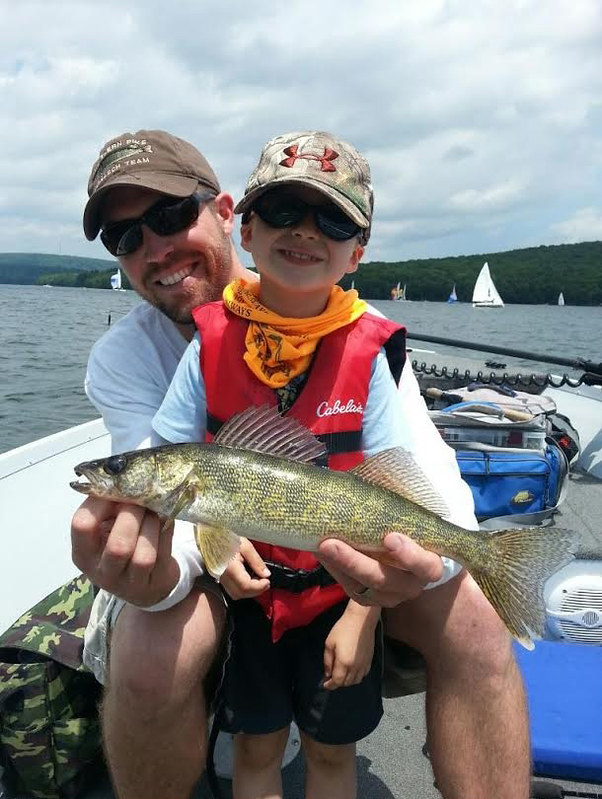
Photo courtesy of Kenny Wampler
Trout anglers should target our coldwater tailwaters of the Savage River and North Branch Potomac River. Flows are back down to fishable levels, and our recent population surveys show there are good numbers of trophy trout in the Catch and Return Trout Management Areas of the North Branch Potomac River. August is the time to start using terrestrial insect patterns such as grasshopper, cricket, and ant patterns. Pictured is Fisheries Technician Kenny Wampler with a trophy wild brown trout from the North Branch Potomac's Catch and Return Trout Fishing Area near Barnum.
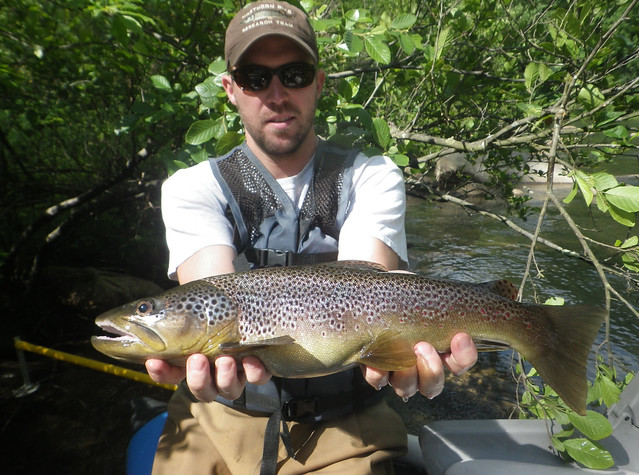
Photo courtesy of Alan Klotz
John Mullican, Western Region II Manager, Inland Fisheries Division sent in a report on the Potomac River fisheries. Following a wet July that saw upper Potomac River levels well above average, flows have now dropped back down to normal summer levels with water temperatures in the mid-80s. Smallmouth bass fishing has been pretty good, but the best bet is to get an early start or fish the evening hours. John is a big fan of throwing surface lures during this time of year and his favorite is a buzzbait or the Pop-R. When the surface action tapers off switch to tubes or stick worms. Prime time finds bass ambushing minnows near boulders, ledges, and grass beds with current nearby.

Photo courtesy of John Mullican
This spring Maryland DNR and U.S. Fish and Wildlife crews conducted an electrofishing survey of the C&O Canal near Great Falls. Regrettably, a single juvenile snakehead was collected in the Violets Lock to Pennyfield Lock section of the canal. With the ample water exchange between the river and the canal, particularly during flood events, it is nearly certain that the northern snakehead has now found its way into the Potomac upstream of Great Falls. In a large, open river system there is no known method to eradicate or stop the spread of northern snakehead. Fishermen have proven to be one of the most effective tools to control snakehead abundance and there is no season, creel limit, or minimum size for snakeheads, but in your possession they must be DEAD. Because the northern snakehead is listed by the USFWS as an injurious species it is subject to the provisions of the Lacey Act, which prohibits the interstate and international transport of live snakeheads punishable by fines up to $250,000 and 5 yrs imprisonment. Anglers are urged to harvest any snakeheads caught and to report northern snakehead caught from the C&O Canal and the Potomac River and tributaries upstream of Great Falls to fishingreports.dnr@maryland.gov. The electrofishing survey also documented a good fishery for largemouth bass and sunfish in the canal. Fishermen can walk or bike the towpath between Violets Lock and Great Falls stopping to cast to likely spots and the abundance of cover.
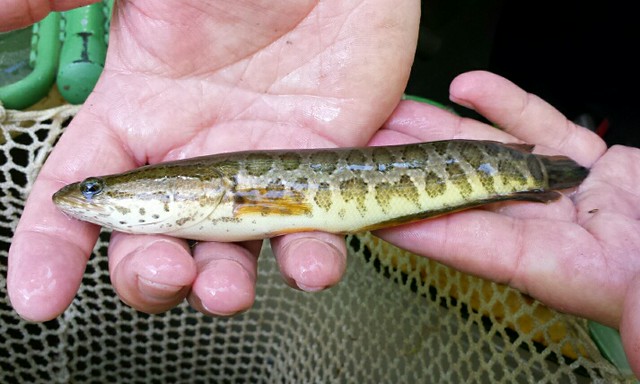
Photo courtesy of John Mullican

Photo courtesy of John Mullican
This is White Marlin Open (WMO) week in Ocean City and there are over 300 boats entered with 238 boats fishing on Wednesday. On the first day a 551 pound blue marlin was brought in, along with undersize white marlin, bigeye tuna, and dolphin. Only 4 boats fished on Tuesday, but much larger boat numbers are expected for the Wednesday-Friday period. Other catches reported before the WMO were wahoo and mahi at the Rockpile, and dolphin in 100-200 fathoms in the Poor Man's. Additional white marlin releases and dolphin were reported near the 800/800, Washington Canyon, and the 461 Lump.
The offshore flounder bite on the ocean reefs and wrecks continues to be strong on strip baits, traditional flounder rigs, and bucktails, with braided line preferred over mono for sensitivity. A few sea bass and triggerfish are also being caught at the wreck sites. The inshore flounder bite is slower with a few fish reported from the East channel and inlet area. Shore anglers are fishing the 2nd-4th street bulkhead on the back bay side and catching some keeper flounder and throwbacks. There is some continued action from the Route 50 bridge as we have been reporting in recent weeks. Bridge fishermen are using Got-cha plugs, bucktail rigs, and jerk baits, and have been catching stripers and bluefish. In the surf, kingfish, spot, and croakers can be targeted with small hooks and bloodworms during the dawn and dusk hours. Small bluefish are caught on cut bait in the surf, usually on mullet. At the inlet bluefish and striped bass are being caught by casting metal lures such as Got-cha plugs or drifting live baits such as spot or eels. I would also expect bucktails and soft plastics to be effective in the inlet area for gamefish. Fishing crab baits and sand fleas in the inlet area around the rocks will catch sheepshead and tautog. Many anglers use cheap used spark plugs and other substitute weights to avoid losing lots of expensive sinkers!
Boom...Morgan
No comments:
Post a Comment